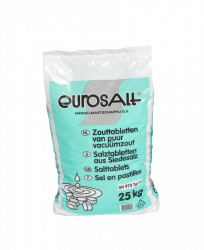Salt in Utrecht
Utrecht is a city and municipality in the Netherlands and the capital of the province of Utrecht. With 344,384 inhabitants (30 April 2017; source: CBS) Utrecht is the fourth city of the Netherlands by population. The city is located in the Randstad and is centrally located at a junction of roads, railways and waterways, making it a leading trade fair and conference city and the fastest growing economic centre - especially in the service sector - of both the Randstad and the Netherlands.
The Utrecht conurbation (contiguous urban area) has a population of 493,667 (January 2015, source: CBS). The Utrecht metropolitan region, which coincides with the former Utrecht Region Administration, comprises 660,873 inhabitants (January 2015, source: CBS). The municipality of Utrecht consists of the residences of Utrecht, Vleuten, De Meern and Haarzuilens. The last three of these fours together form a district with almost 47,000 inhabitants within the municipality of Utrecht. The name of this district is Vleuten-De Meern. It borders the district Leidsche Rijn with over 32,000 inhabitants. These two districts together form the VINEX-location Leidsche Rijn, the large expansion of the city of Utrecht to the west, with in 2016 about 80.000 inhabitants, which will grow to about 100.000 within a few years. The eight other districts of this municipality together form the city of Utrecht from before the large expansion. Utrecht is surrounded by the municipalities of De Bilt, Stichtse Vecht, Woerden, Montfoort, IJsselstein, Nieuwegein, Houten, Bunnik and Zeist.
Road salt is also a generally accepted de-icing agent in Utrecht. It lowers the freezing point of water. The salt (almost always sodium chloride, NaCl, sometimes calcium chloride, CaCl2) mixes with the water present (ice or snow) to form brine. Because brine has a lower freezing point than water, it will freeze less quickly so that less slipperiness occurs. After sprinkling salt, there must be sufficient traffic to get a good mixture. Brine is a mixture of water and salt. When a substance is dissolved in water, the freezing point of the solution drops. For example, if water contains 1 molal of sodium chloride, the freezing point will be lowered by about 1.86°C. The freezing point reduction can be calculated using cryoscopic constant. At lower and lower temperatures sodium chloride becomes less effective. To still melt ice, calcium chloride can be used, which is however much more expensive.
Wet salt in Utrecht
Nowadays wet salt is mostly used. In that case, the spreading machine is equipped with liquid tanks (usually on the side), in which pre-mixed brine is stored. The dry salt is mixed with brine before it is released, where the salt grains clump together. The advantage of this is that the mixture is more homogeneous than dry salt, allowing it to be scattered much more accurately. In addition, much less dust is created behind the spreader. It is therefore possible for the spreader to drive faster, up to 70 km/h (against a maximum of 40 km/h with dry salt spreading). Wet salt also adheres better to the road surface due to crystallization and because wet salt blows less quickly, it is also suitable for preventive spreading.
Effects of brine in Utrecht
Spreading salt is not without risk. For example, car bodies need to be well protected against oxidation because brine reacts strongly with metals.
Another influence is the salinization of the soil next to the road, which affects the flora's environment. For example, salt-loving plants, such as English grass, can be found along many roads, far from the coasts where they are normally found.
However, due to increasingly sophisticated equipment and new techniques, such as wet salt spreading, the accuracy with which the salt is brought onto the road has been greatly increased in recent years, which has resulted in a lower environmental impact. Not only is the dosage used a lot lower than before (often only 10 g/m2 is spread), also much less is spread on the verge.




